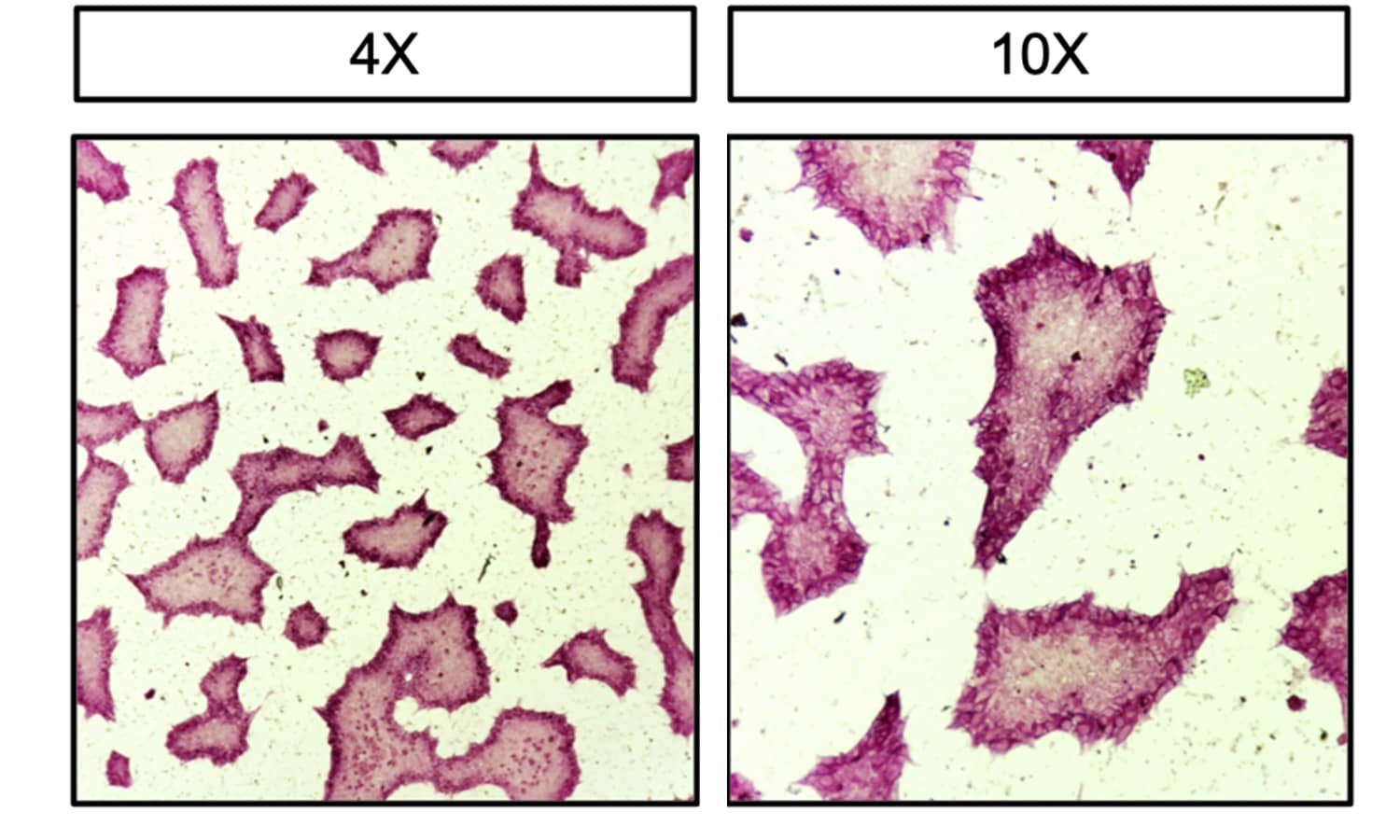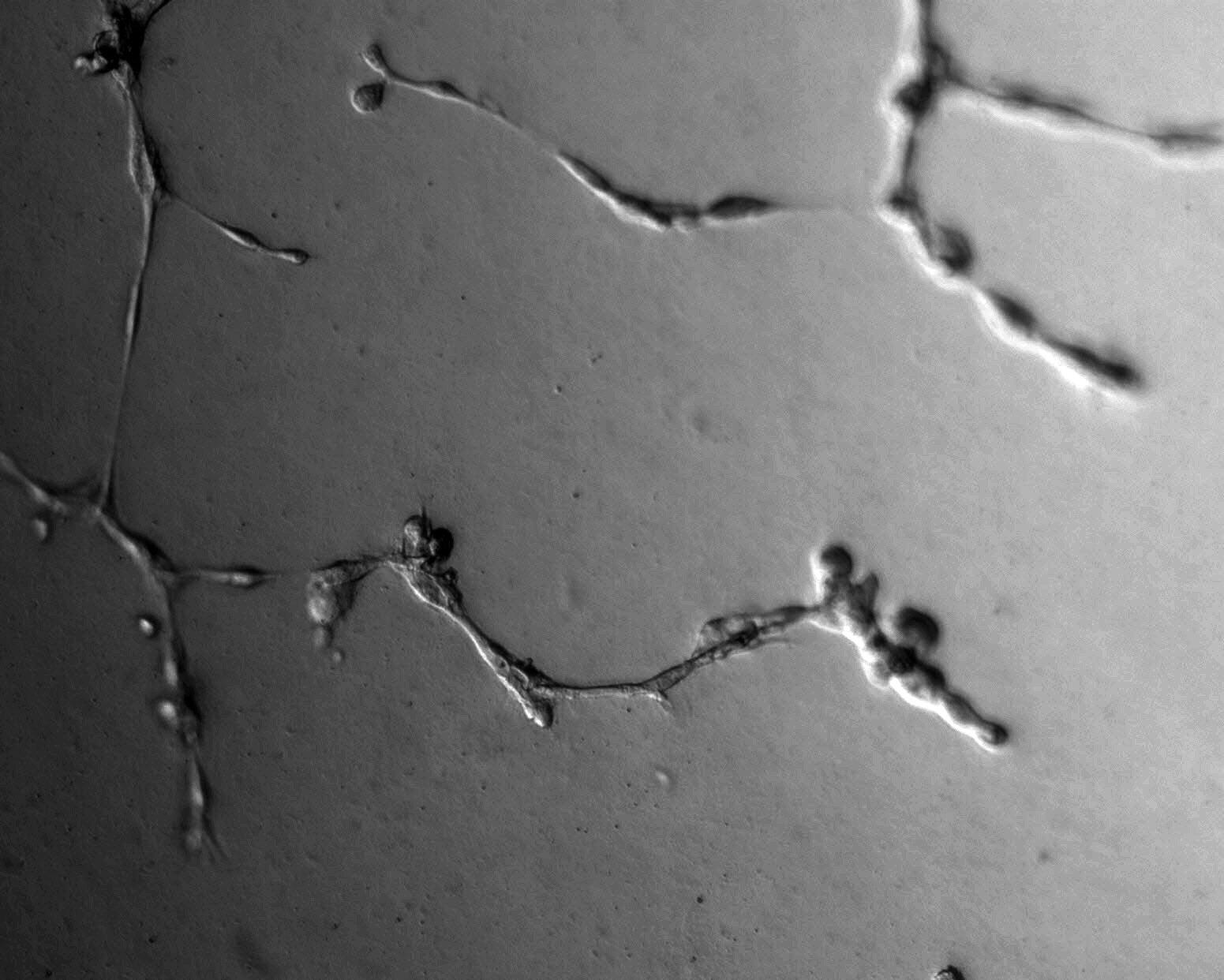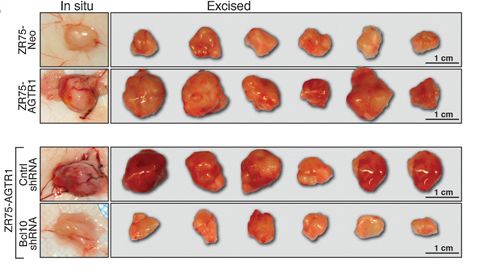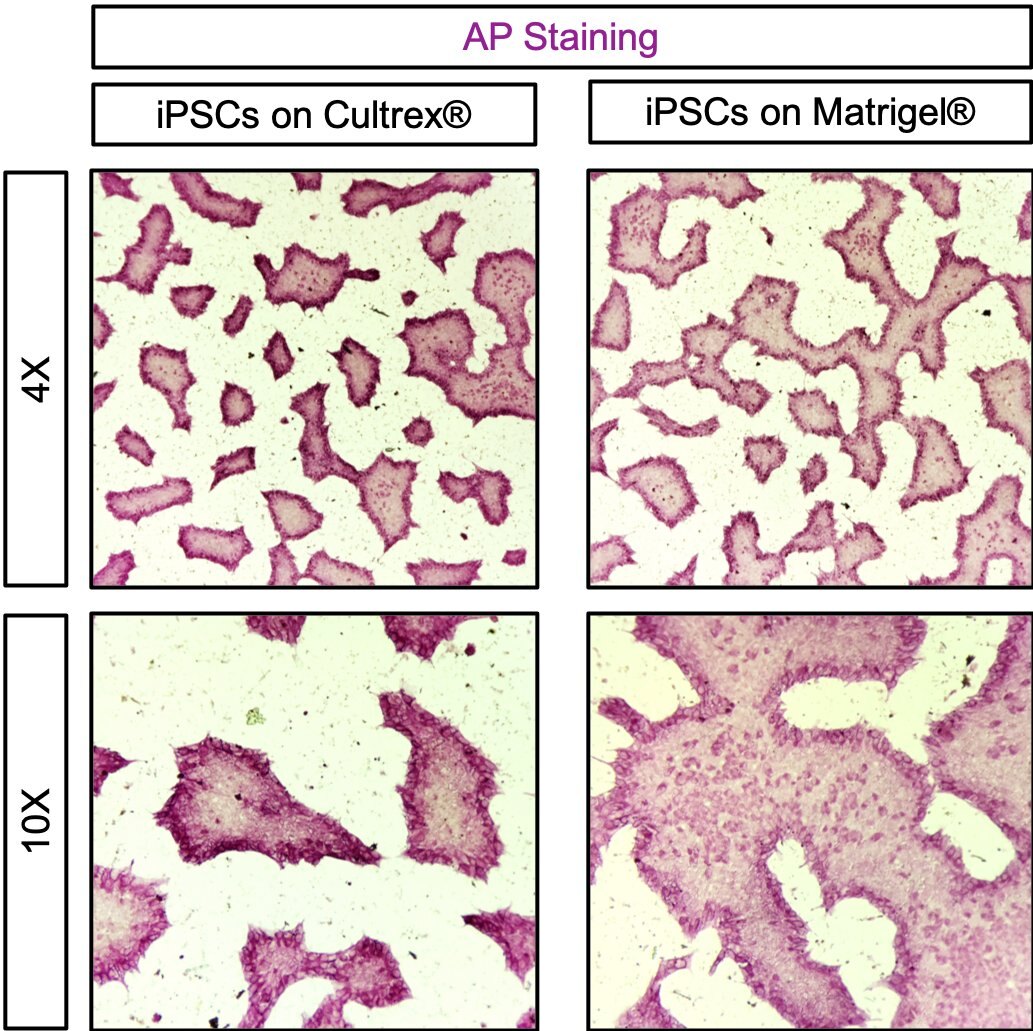Cultrex Reduced Growth Factor Basement Membrane Extract, PathClear
Try it on your cultures! Request a Sample of Cultrex RGF BME
Cultrex Reduced Growth Factor Basement Membrane Extract, PathClear Summary
Cultrex Reduced Growth Factor Basement Membrane Extract (RGF BME) is an extracellular matrix hydrogel that has been used extensively in general cell culture applications to study cell attachment, proliferation, and invasion. It is ideal for cultures that require limited reduced growth factor conditions.Key Benefits
• Ideal for general cell culture application
• Reduced growth factor formulation provides a more defined culture system
• Polymerizes at 37°C to form a reconstituted basement membrane
• Quality controlled for peformance consistency
Why Use Cultrex RGF BME?
Cultrex Reduced Growth Factor Basement Membrane Extract (RGF BME) is a soluble form of basement membrane purified from Engelbreth-Holm-Swarm (EHS) tumor. It is processed to reduce matrix-associated growth factors to provide a matrix that can be used to create a more defined model system. This extract provides a natural extracellular matrix hydrogel that polymerizes at 37°C to form a reconstituted basement membrane. Cultrex RGF BME can be used in multiple applications, including maintaining growth or promoting differentiation of primary endothelial, epithelial, smooth muscle, stem cells, and organoid/3-D cell cultures. It can also be utilized in cell attachment, neurite outgrowth, angiogenesis, in vitro cell invasion, and in vivo tumorigenicity assays.
Basement membranes are continuous sheets of specialized extracellular matrix that form an interface between endothelial, epithelial, muscle, or neuronal cells and their adjacent stroma and that play an essential role in tissue organization by influencing cell adhesion, migration, proliferation, and differentiation. The major components of BME include laminin, collagen IV, entactin, and heparin sulfate proteoglycans.
Specifications
Limitations
For research use only. Not for diagnostic use.
Product Datasheets
Scientific Data
 View Larger
View Larger
Assessment of Pluripotency on Cultrex RGF BME. Alkaline Phosphatase (AP) staining was used to characterize the pluripotency of human induced pluripotent stem (iPS) cells cultured on Cultrex Reduced Growth Factor BME (Catalog # 3433-010-01). Images are shown in 4X and 10X magnification. Data courtesy of GABAeron.
Citations for Cultrex Reduced Growth Factor Basement Membrane Extract, PathClear
R&D Systems personnel manually curate a database that contains references using R&D Systems products. The data collected includes not only links to publications in PubMed, but also provides information about sample types, species, and experimental conditions.
42
Citations: Showing 1 - 10
Filter your results:
Filter by:
-
Development of Polarity-Reversed Endometrial Epithelial Organoids
Authors: Ahmad, V;Yeddula, SGR;Telugu, BP;Spencer, TE;Kelleher, AM;
bioRxiv : the preprint server for biology 2023-08-19
-
Phosphoproteomics guides effective low-dose drug combinations against pancreatic ductal adenocarcinoma
Authors: Vall�s-Mart�, A;Mantini, G;Manoukian, P;Waasdorp, C;Sarasqueta, AF;de Goeij-de Haas, RR;Henneman, AA;Piersma, SR;Pham, TV;Knol, JC;Giovannetti, E;Bijlsma, MF;Jim�nez, CR;
Cell reports 2023-06-01
-
Uridine-derived ribose fuels glucose-restricted pancreatic cancer
Authors: Nwosu, ZC;Ward, MH;Sajjakulnukit, P;Poudel, P;Ragulan, C;Kasperek, S;Radyk, M;Sutton, D;Menjivar, RE;Andren, A;Apiz-Saab, JJ;Tolstyka, Z;Brown, K;Lee, HJ;Dzierozynski, LN;He, X;Ps, H;Ugras, J;Nyamundanda, G;Zhang, L;Halbrook, CJ;Carpenter, ES;Shi, J;Shriver, LP;Patti, GJ;Muir, A;Pasca di Magliano, M;Sadanandam, A;Lyssiotis, CA;
Nature 2023-05-17
-
The Dietary Supplement Taurine Suppresses Ovarian Cancer Growth
Authors: D Centeno, S Farsinejad, E Kochetkova, T Volpari, A Klupczynsk, D Kung, T Polotaye, E Hyde, T Pavlovic, S Alshehri, W Sullivan, S Plewa, FJ Monsma, J Matysiak, M Zaborowski, A Difeo, LA Martin, E Norberg, M Iwanicki
bioRxiv : the preprint server for biology, 2023-02-27;0(0):. 2023-02-27
-
Bone metastasis initiation is coupled with bone remodeling through osteogenic differentiation of NG2+ cells
Authors: W Zhang, Z Xu, X Hao, T He, J Li, Y Shen, K Liu, Y Gao, J Liu, D Edwards, AM Muscarella, L Wu, L Yu, L Xu, X Chen, YH Wu, IL Bado, Y Ding, S Aguirre, H Wang, Z Gugala, RL Satcher, ST Wong, XH Zhang
Cancer Discovery, 2023-02-06;0(0):. 2023-02-06
-
Early Mechanisms of Chemoresistance in Retinoblastoma
Authors: MG Zhang, JN Kuznetsoff, DA Owens, RA Gallo, K Kalahasty, AM Cruz, S Kurtenbach, ZM Correa, D Pelaez, JW Harbour
Cancers, 2022-10-10;14(19):. 2022-10-10
-
Delayed regression of laser-induced choroidal neovascularization in TNFalpha-null mice
Authors: H Iwanishi, O Yamanaka, T Sumioka, S Yasuda, M Miyajima, S Saika
Journal of Cellular and Molecular Medicine, 2022-09-20;0(0):. 2022-09-20
-
Frequently used antiemetic agent dexamethasone enhances the metastatic behaviour of select breast cancer cells
Authors: M Crozier, J Tubman, BA Fifield, RM Ferraiuolo, J Ritchie, K Zuccato, E Mailloux, I Sinha, C Hamm, LA Porter
PLoS ONE, 2022-09-15;17(9):e0274675. 2022-09-15
-
Tumor activated platelets induce vascular mimicry in mesenchymal stem cells and aid metastasis
Authors: A Bhuniya, A Sarkar, A Guha, PR Choudhury, S Bera, J Sultana, M Chakravart, S Dhar, J Das, I Guha, N Ganguly, S Banerjee, A Bose, R Baral
Cytokine, 2022-08-15;158(0):155998. 2022-08-15
-
Interaction of immune checkpoint PD-1 and chemokine receptor 4 (CXCR4) promotes a malignant phenotype in pancreatic cancer cells
Authors: MM Harper, M Lin, MJ Cavnar, PK Pandalai, RA Patel, M Gao, J Kim
PLoS ONE, 2022-07-07;17(7):e0270832. 2022-07-07
-
Sulfonated Amphiphilic Poly(alpha)glutamate Amine-A Potential siRNA Nanocarrier for the Treatment of Both Chemo-Sensitive and Chemo-Resistant Glioblastoma Tumors
Authors: A Krivitsky, S Pozzi, E Yeini, S Israeli Da, T Zur, S Golan, V Krivitsky, N Albeck, E Pisarevsky, P Ofek, A Madi, R Satchi-Fai
Pharmaceutics, 2021-12-20;13(12):. 2021-12-20
-
Functional States in Tumor-Initiating Cell Differentiation in Human Colorectal Cancer
Authors: MK Zowada, SM Tirier, SM Dieter, TG Krieger, A Oberlack, RL Chua, M Huerta, FW Ten, K Laaber, J Park, K Jechow, T Müller, M Kalxdorf, M Kriegsmann, K Kriegsmann, F Herbst, J Krijgsveld, M Schneider, R Eils, H Glimm, C Conrad, CR Ball
Cancers, 2021-03-04;13(5):. 2021-03-04
-
Somatic mutations and single-cell transcriptomes reveal the root of malignant rhabdoid tumours
Authors: L Custers, E Khabirova, THH Coorens, TRW Oliver, C Calandrini, MD Young, FA Vieira Bra, P Ellis, L Mamanova, H Segers, A Maat, M Kool, EW Hoving, MM van den He, J Nicholson, K Straathof, L Hook, RR de Krijger, C Trayers, K Allinson, S Behjati, J Drost
Nature Communications, 2021-03-03;12(1):1407. 2021-03-03
-
Activation of the S100A7/RAGE Pathway by IGF-1 Contributes to Angiogenesis in Breast Cancer
Authors: MG Muoio, M Talia, R Lappano, AH Sims, V Vella, F Cirillo, L Manzella, M Giuliano, M Maggiolini, A Belfiore, EM De Frances
Cancers, 2021-02-04;13(4):. 2021-02-04
-
A prolonged exposure of human lung carcinoma epithelial cells to benzo[a]pyrene induces p21-dependent epithelial-to-mesenchymal transition (EMT)-like phenotype
Authors: M Hýž?alová, J Procházkov, S Strapá?ová, L Svržková, O Vacek, R Fedr, Z Andrysík, E Hrubá, H Líbalová, J Kléma, J Topinka, J Mašek, K Sou?ek, J Vondrá?ek, M Machala
Chemosphere, 2020-09-10;263(0):128126. 2020-09-10
-
In�Vivo Cell Fate Tracing Provides No Evidence for Mesenchymal to Epithelial Transition in Adult Fallopian Tube and Uterus
Authors: A Ghosh, SM Syed, M Kumar, TJ Carpenter, JM Teixeira, N Houairia, S Negi, PS Tanwar
Cell Rep, 2020-05-12;31(6):107631. 2020-05-12
-
Cancer-associated fibroblasts promote immunosuppression by inducing ROS-generating monocytic MDSCs in lung squamous cell carcinoma
Authors: H Xiang, CP Ramil, J Hai, C Zhang, H Wang, AA Watkins, R Afshar, P Georgiev, MA Sze, XS Song, PJ Curran, M Cheng, JR Miller, D Sun, A Loboda, Y Jia, LY Moy, A Chi, PE Brandish
Cancer Immunol Res, 2020-02-19;0(0):. 2020-02-19
-
Endometrial Axin2+ Cells Drive Epithelial Homeostasis, Regeneration, and Cancer following Oncogenic Transformation
Authors: SM Syed, M Kumar, A Ghosh, F Tomasetig, A Ali, RM Whan, D Alterman, PS Tanwar
Cell Stem Cell, 2019-12-26;26(1):64-80.e13. 2019-12-26
-
mTOR and autophagy pathways are dysregulated in murine and human models of Schaaf-Yang syndrome
Authors: E Crutcher, R Pal, F Naini, P Zhang, M Laugsch, J Kim, A Bajic, CP Schaaf
Sci Rep, 2019-11-04;9(1):15935. 2019-11-04
-
Interrogation of Phenotypic Plasticity between Epithelial and Mesenchymal States in Breast Cancer
Authors: S Bhatia, J Monkman, T Blick, C Pinto, M Waltham, SH Nagaraj, EW Thompson
J Clin Med, 2019-06-21;8(6):. 2019-06-21
-
Vascular-endothelial response to IDH1 mutant fibrosarcoma secretome and metabolite: implications on cancer microenvironment
Authors: MJ Mao, DE Leonardi
Am J Cancer Res, 2019-01-01;9(1):122-133. 2019-01-01
-
Isogenic blood-brain barrier models based on patient-derived stem cells display inter-individual differences in cell maturation and functionality.
Authors: Patel R, Page S, Al-Ahmad A
J Neurochem, 2017-05-14;142(1):74-88. 2017-05-14
-
Metformin Reduces Prostate Tumor Growth, in a Diet-Dependent Manner, by Modulating Multiple Signaling Pathways.
Authors: Sarmento-Cabral A, L-Lopez F, Gahete M, Castano J, Luque R
Mol Cancer Res, 2017-04-06;15(7):862-874. 2017-04-06
-
Preclinical Antitumor Efficacy of BAY 1129980-a Novel Auristatin-Based Anti-C4.4A (LYPD3) Antibody-Drug Conjugate for the Treatment of Non-Small Cell Lung Cancer.
Authors: Willuda J, Linden L, Lerchen H, Kopitz C, Stelte-Ludwig B, Pena C, Lange C, Golfier S, Kneip C, Carrigan P, McLean K, Schuhmacher J, von Ahsen O, Muller J, Dittmer F, Beier R, El Sheikh S, Tebbe J, Leder G, Apeler H, Jautelat R, Ziegelbauer K, Kreft B
Mol Cancer Ther, 2017-03-14;16(5):893-904. 2017-03-14
-
Activation of CD137 Signaling Promotes Angiogenesis in Atherosclerosis via Modulating Endothelial Smad1/5-NFATc1 Pathway.
Authors: Weng J, Wang C, Zhong W, Li B, Wang Z, Shao C, Chen Y, Yan J
J Am Heart Assoc, 2017-03-13;6(3):. 2017-03-13
-
Hyaluronan-Binding Protein Involved in Hyaluronan Depolymerization Controls Endochondral Ossification through Hyaluronan Metabolism
Authors: M Shimoda, H Yoshida, S Mizuno, T Hirozane, K Horiuchi, Y Yoshino, H Hara, Y Kanai, S Inoue, M Ishijima, Y Okada
Am. J. Pathol, 2017-03-08;0(0):. 2017-03-08
-
Transposon mutagenesis identifies genes that cooperate with mutant Pten in breast cancer progression
Proc. Natl. Acad. Sci. U.S.A., 2016-11-14;0(0):. 2016-11-14
-
KLF6 Suppresses Metastasis of Clear Cell Renal Cell Carcinoma via Transcriptional Repression of E2F1.
Authors: Gao Y, Li H, Ma X, Fan Y, Ni D, Zhang Y, Huang Q, Liu K, Li X, Wang L, Gu L, Yao Y, Ai Q, Du Q, Song E, Zhang X
Cancer Res, 2016-10-25;77(2):330-342. 2016-10-25
-
Wnt signaling promotes breast cancer by blocking ITCH-mediated degradation of the YAP/TAZ transcriptional coactivator WBP2
Cancer Res, 2016-08-30;0(0):. 2016-08-30
-
PTEN inhibits PREX2-catalyzed activation of RAC1 to restrain tumor cell invasion.
Authors: Mense S, Barrows D, Hodakoski C, Steinbach N, Schoenfeld D, Su W, Hopkins B, Su T, Fine B, Hibshoosh H, Parsons R
Sci Signal, 2015-03-31;8(370):ra32. 2015-03-31
-
Conditioned medium from human amniotic mesenchymal stromal cells limits infarct size and enhances angiogenesis.
Authors: Danieli P, Malpasso G, Ciuffreda M, Cervio E, Calvillo L, Copes F, Pisano F, Mura M, Kleijn L, de Boer R, Viarengo G, Rosti V, Spinillo A, Roccio M, Gnecchi M
Stem Cells Transl Med, 2015-03-30;4(5):448-58. 2015-03-30
-
Effects of ulipristal acetate on human embryo attachment and endometrial cell gene expression in an in vitro co-culture system.
Authors: Berger C, Boggavarapu N, Menezes J, Lalitkumar P, Gemzell-Danielsson K
Hum Reprod, 2015-03-03;30(4):800-11. 2015-03-03
-
The hippo pathway effector YAP regulates motility, invasion, and castration-resistant growth of prostate cancer cells.
Authors: Zhang L, Yang S, Chen X, Stauffer S, Yu F, Lele S, Fu K, Datta K, Palermo N, Chen Y, Dong J
Mol Cell Biol, 2015-02-02;35(8):1350-62. 2015-02-02
-
PI3K/mTOR dual inhibitor VS-5584 preferentially targets cancer stem cells.
Authors: Kolev V, Wright Q, Vidal C, Ring J, Shapiro I, Ricono J, Weaver D, Padval M, Pachter J, Xu Q
Cancer Res, 2014-11-28;75(2):446-55. 2014-11-28
-
The M33 G protein-coupled receptor encoded by murine cytomegalovirus is dispensable for hematogenous dissemination but is required for growth within the salivary gland.
Authors: Bittencourt F, Wu S, Bridges J, Miller W
J Virol, 2014-08-06;88(20):11811-24. 2014-08-06
-
Vesicle-associated membrane protein 2 (VAMP2) but Not VAMP3 mediates cAMP-stimulated trafficking of the renal Na+-K+-2Cl- co-transporter NKCC2 in thick ascending limbs.
Authors: Caceres P, Mendez M, Ortiz P
J Biol Chem, 2014-07-09;289(34):23951-62. 2014-07-09
-
GPER mediates activation of HIF1alpha/VEGF signaling by estrogens.
Authors: De Francesco E, Pellegrino M, Santolla M, Lappano R, Ricchio E, Abonante S, Maggiolini M
Cancer Res, 2014-06-03;74(15):4053-64. 2014-06-03
-
Harvest of superficial layers of fat with a microcannula and isolation of adipose tissue-derived stromal and vascular cells.
Authors: Trivisonno A, Di Rocco G, Cannistra C, Finocchi V, Torres Farr S, Monti M, Toietta G
Aesthet Surg J, 2014-03-31;34(4):601-13. 2014-03-31
-
Function of carbonic anhydrase IX in glioblastoma multiforme.
Authors: Proescholdt M, Merrill M, Stoerr E, Lohmeier A, Pohl F, Brawanski A
Neuro Oncol, 2012-10-16;14(11):1357-66. 2012-10-16
-
Protein kinase D1 mediates anchorage-dependent and -independent growth of tumor cells via the zinc finger transcription factor Snail1.
Authors: Eiseler T, Kohler C, Nimmagadda S, Jamali A, Funk N, Joodi G, Storz P, Seufferlein T
J Biol Chem, 2012-07-12;287(39):32367-80. 2012-07-12
-
Combination of an allosteric Akt Inhibitor MK-2206 with etoposide or rapamycin enhances the antitumor growth effect in neuroblastoma.
Authors: Li Z, Yan S, Attayan N, Ramalingam S, Thiele C
Clin Cancer Res, 2012-05-01;18(13):3603-15. 2012-05-01
-
CLM94, a novel cyclic amide with anti-VEGFR-2 and antiangiogenic properties, is active against primary anaplastic thyroid cancer in vitro and in vivo.
Authors: Antonelli A, Bocci G, La Motta C, Ferrari S, Fallahi P, Ruffilli I, Di Domenicantonio A, Fioravanti A, Sartini S, Minuto M, Piaggi S, Corti A, Ali G, Di Desidero T, Berti P, Fontanini G, Danesi R, Da Settimo F, Miccoli P
J Clin Endocrinol Metab, 2012-01-25;97(4):E528-36. 2012-01-25
FAQs
-
What kinds of tumor cells or biopsy specimens grow in vivo with Cultrex® BME?
Many cell lines and tumor biopsy specimens (usually cut into small fragments) have been found to grow in vivo when implanted with Cultrex® BME. These include melanoma, intestinal, prostate, breast, lung, renal, and liver cancers as well as the 3T3 mouse embryonic fibroblast cell line.
-
How does Cultrex® Basement Membrane Extract (BME) promote cell differentiation?
All epithelial and endothelial cells are in contact with a basement membrane matrix on at least one of their surfaces. By providing them with their natural matrix in vitro as a substrate for the cells that provides biological cues, the cells can assume a more physiological morphology (i.e. correct shape) and begin expression of cell-lineage specific proteins. Two-dimensional plastic surfaces, in combination with serum-containing media, cause cells to flatten, proliferate and de-differentiate.
-
How should Cultrex Basement Membrane Extract (BME) be stored and handled?
Cultrex BME should be stored at or below -20°C for optimal stability. Preparation of working aliquots is recommended. Cultrex BME should be thawed overnight on ice at 4°C, however long term storage at 4°C is not recommended. Freeze/thaw cycles and gel-liquid phase transitions should be avoided, since they can compromise product integrity.
-
What is the Tube Formation Assay?
The Tube Formation Assay is based on the ability of endothelial cells to form three-dimensional capillary-like tubular structures when cultured on a hydrogel of reconstituted basement membrane, such as Cultrex Basement Membrane Extract (BME).
-
What are the advantages of the Tube Formation Assay?
The Tube Formation Assay is the most widely used in vitro angiogenesis assay. The assay is rapid, inexpensive and quantifiable. It can be used to identify potentially angiogenic and anti-angiogenic factors, to determine endothelial cell phenotype, and to study pathways and mechanisms involved in angiogenesis. It can be performed in a high throughput mode to screen for a large number of compounds.
-
What cell types can be used in the Tube Formation Assay?
The Tube Formation Assay is specific for endothelial cells, either primary cells or immortalized cell lines. Only endothelial cells form capillary-like structures with a lumen inside. Other endothelial cell types form other structures.
-
What are the variables associated with the Tube Formation Assay?
The major variables associated with tube formation are composition of the Cultrex Basement Membrane Extract (BME) hydrogel, thickness of the hydrogel, cell density, composition of angiogenic factors in the assay medium, and assay period.
-
Which Cultrex Basement Membrane Extract (BME) should I use for the Tube Formation Assay?
Cultrex Reduced Growth Factor BME (RGF BME) is generally used for testing compounds that promote angiogenesis because formation of capillary-like structures (tubes) is significantly less compared to non-growth factor reduced varieties of Cultrex BME. The Cultrex In Vitro Angiogeneis Assay (Tube Formation) includes a qualified production lot of Cultrex RGF BME that exhibits reduced background tube formation in the absence of angiogenic factors.
-
How do I reduce spontaneous formation of tubular structures on Cultrex BME in the absence of angiogenic factors?
Primary endothelial cells, such as Human Umbilical Vein Endothelial Cells (HUVECs) form capillary-like structures in the absence of added angiogenic factors less often than immortalized endothelial cells. Generally, reducing the number of cells per cm2 plated onto Cultrex BME will result in less background or spontaneous tube formation. Titrate the number of cells and find optimal conditions for your specific cell line. When endothelial cells fully form capillary structures in response to angiogenic activators, but not in their absence, you may proceed.
-
Can cells grown in Basement Membrane Extract (BME), such as Catalog # 3433-005-01, be used in Flow Cytometry?
For preparation of a single cell suspension for applications such as FACS and re-culturing, digestion of the matrix and cell-cell bonds may be facilitated using enzymes such as Trypsin or Dispase. Our CellSperse, cat# 3450-048-05, is similar to Dispase, and can also be used for this purpose. However, some markers may be susceptible to degradation from CellSperse treatment. It is recommended to consult the literature for design of experiments for the particular cell type and markers of interest.
Reviews for Cultrex Reduced Growth Factor Basement Membrane Extract, PathClear
Average Rating: 4.8 (Based on 8 Reviews)
Have you used Cultrex Reduced Growth Factor Basement Membrane Extract, PathClear?
Submit a review and receive an Amazon gift card.
$25/€18/£15/$25CAN/¥75 Yuan/¥1250 Yen for a review with an image
$10/€7/£6/$10 CAD/¥70 Yuan/¥1110 Yen for a review without an image
Filter by:
The hydrogel formed a great three-dimensional matrix allowing Schwann cell growth and DRG neuron neurite outgrowth.
Tube formation of Human Coronary Artery Endothelial cells imaged 6 hours after seeding.
Reason for Rating: I used Cultrex for an xenograft tumor growth Invivo study. I mixed Breast Cancer cells and cultrex in an 1:1 ratio and injected into mice and followed tumor growth. Cultrex helped to hold the cells together and which helped with the tumor growth.




